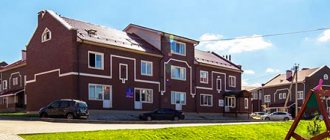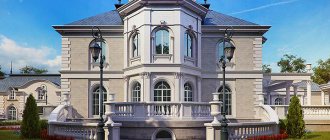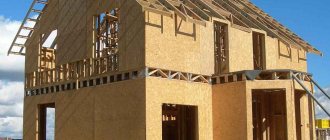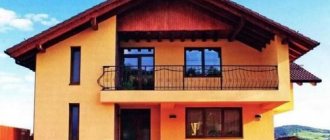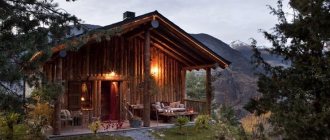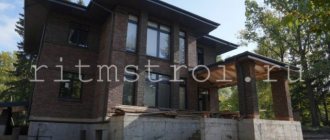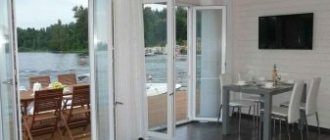The GZHN body refuses to make changes to the register of licenses at the request of the management organization for various reasons, which are then often disputed in court. We are talking about a case that reached the Supreme Court of the Russian Federation, in which the question was considered whether the State Housing Inspectorate was right in considering a two-apartment building to be residential and not multi-apartment.
Why did the RF Armed Forces invalidate some requirements No. 938/pr
1781311
The house has two or more apartments with separate exits
Case No. A70-15067/2019 reached the Supreme Court of the Russian Federation, and the main issue that was considered in all instances was determining the status of the house - whether it was multi-apartment or individual residential.
It started with the fact that in Tyumen the administration held an open competition to select a management organization for a building in which there are only two apartments. The management company that won the competition submitted an application and a package of documents to the GZHN body to include the house in the register of regional licenses: copies of the selection protocol and the management agreement with the owners.
Based on the results of consideration of the application, the State Housing Inspectorate refused the company to make changes to the register, citing paragraphs. “a” clause 5 of order No. 938/pr: The MA did not indicate the address of the apartment building in the application, did not attach a copy of the competitive selection protocol and the management agreement. GZHI noted that all the data in the documents does not relate to apartment buildings, but to a residential building, since the apartments, according to the technical documentation, do not have access to common areas, but have separate entrances. The building cannot be classified as an apartment building.
The managing organization did not agree with this position of the GZHI and filed a lawsuit demanding that the department’s refusal be declared illegal and oblige the GZHI to make changes to the register of licenses.
Problems of joint ownership of a house and land
The situation when several owners own a house and a plot is not simple in itself. Especially when the co-owners are in hostile relationships and often simply cannot come to agreements on everyday issues.
However, since the real estate remains in shared ownership, they often need to make some general decisions regarding:
- registration of new residents;
- carrying out repair activities;
- reconstruction of technical networks.
In complex relationships, this is quite difficult to do, or even impossible, and most owners try to allocate their share by dividing property.
This can be done by separating a part of the house and the territory underneath it, in other words, through real division.
The apartments have exits to common areas or to the common plot of land where the house is located
The decisive factor in the case was the decision of the court of first instance, which was upheld in the courts of appeal and cassation, and was also confirmed by the Supreme Court of the Russian Federation. It was based on the following legislation:
- A residential building is an individually defined building consisting of rooms, as well as premises for auxiliary use (Part 2 of Article 16 of the Housing Code of the Russian Federation).
- An apartment building is a collection of two or more apartments that have independent exits either to a land plot adjacent to a residential building or to common areas (clause 6 of the Decree of the Government of the Russian Federation dated January 28, 2006 No. 47). Also, the MKD must contain elements of the common property of apartment owners.
- Elements of public property in an apartment building include, among other things, the land plot on which it is located (clause 4, part 1, article 36 of the Housing Code of the Russian Federation).
The court took into account that the disputed object is located on a land plot with a single cadastral number. The site is intended for an apartment building. The inspection report of the building indicates the presence of two apartments. Consequently, this is an apartment building, and not an individual residential building, and the administration had the legal right to hold an open competition, and the management company had the legal right to participate in it and conclude a management agreement with the owners. The judge granted the company's claim.
Does GZHI need a copy of the signed DU to change the register of licenses?
58022
Disadvantages of houses for three owners
- Despite the cost-effectiveness of low-rise apartment buildings, they are still inferior to individual single-family houses, primarily due to the lack of privacy and personal space.
- Added to the disadvantages are the problems that arise with the land, which is a common local area.
- Questions may also arise regarding the maintenance of common areas, such as the roof.
- A disadvantage may also be that there will be no proximity to transport routes if you build a house outside the city.
- The small size of the land plot can spoil the impression.
Original project of a house for three owners
In general, it can be noted that the indicated disadvantages do not cover all the advantages of residential block houses, which can be called a universal type of housing. This type of building can be built on any landscape and is cost-effective. In addition, thanks to various design solutions, the street acquires a unique and beautiful appearance.
Apartment owners have common property
GZHI filed an appeal, pointing out that the land plot, although it belongs to the common property of the apartment building, is not a common premises. Therefore, the presence of such a plot cannot be a sign that the house is an apartment building. A residential building consisting of two apartments with separate exits to a land plot without direct access to common areas is not multi-apartment. The disputed house has the characteristics of a residential building of a blocked development in accordance with Art. 49 Civil Code of the Russian Federation.
The Court of Appeal, repeating the arguments of its colleagues and fully agreeing with them, also added that
- The disputed building is recognized as an apartment building due to the presence of common property in it: a single roof and a single solid facade, a common foundation, one plot of land, and intra-building utilities for energy supply.
- The presence of common property entails the possibility of managing it by a specialized organization.
- The technical passport of the house indicates the presence of attic floors; accordingly, the house has an attic, which is a room intended to serve more than one apartment, and is part of the common property of the owners of the premises.
The Court of Appeal confirmed the legality of recognizing the building as an apartment building and, therefore, the illegality of the refusal of the State Housing Authority to make changes to the register of licenses according to the application of the management organization. The dispute moved to the cassation court, which completely agreed with the previous decisions. The Supreme Court of the Russian Federation, to which the State Housing Inspectorate appealed, refused to consider the complaint, having found no grounds for this.
As a result, the house was recognized as an apartment building, and the State Housing Authority was obliged to make changes to the register of licenses of the region in accordance with the results of an open competition for the selection of management entities.
On the extension of the contract with the management company, concluded based on the results of an open competition
80481
How to divide a house? And what can be shared and what cannot?
The actual possibility of dividing a house and land does not always coincide with the legal possibilities. The divisibility of a property, from a legal point of view, has an independent meaning and does not necessarily coincide with the real possibility of dividing walls and rooms.
All existing real estate objects are recognized as physically divisible, but they are legally divisible only if it is possible to divide them into parts in such a way that each part maintains homogeneity, that is, remains “residential” for its intended purpose and so that its use does not violate the rights of others copyright holders and users.
In other words, when dividing a house, each owner must have his own entrance, kitchen, bathroom, etc.
For the correct division of real estate, the law introduced the concept of Signs of residential premises:
- appointment;
- suitability for habitation;
- isolation;
- belonging to the category of immovable objects.
Of course, the last of the signs is the main one, however, the absence of any of the listed signs gives grounds to consider the premises non-residential.
It is unacceptable to divide a house as a result of which an independent part is formed that is not intended for living (for example, a built-in garage or just a kitchen).
On a note
The status of a house as an apartment building is important for the owners and, as in this case, for the municipality and management organization. If the house is multi-apartment, then questions arise about the method of managing it, carrying out current and major repairs of common property, forming a capital repair fund, recognizing the house as unsafe, and others.
As the courts indicated in the case considered, if a residential building with two or more apartments has common property: a roof, an attic, a basement, a plot of land, communications, then such a building is recognized as an apartment building, regardless of whether the apartments are equipped with exits to common premises.
Designing a three-family house
The layouts of dwellings for 3 families may be the same, or they may differ significantly, which creates multiple conditions for individual choice.
Most often, the design of such a house contains one or two floors with a basement. That is, living rooms occupy two or three levels.
When designing blocked houses, it is customary to carry out zoning, that is, separation of the utility part and sleeping quarters.
This zoning is called cottage zoning, since it was originally used in cottage-type houses. For example, if the project provides, in a two-story block house for 3 families, a kitchen, hall, dining room, living room, and bathroom may be located on the ground floor, and a bathroom, office, children’s room, and bedrooms may be located on the second floor. The basement floor can be occupied by a garage, gym, storage room or boiler room. In luxury houses, you can also provide a swimming pool, sauna and billiard room.
Townhouse - MKD or residential building of a blocked building
Appendix B “Terms and Definitions” to SNiP 02/31/2001 states that this document applies to blocked houses consisting of two or more autonomous residential blocks attached to each other, each of which has direct access to the apartment plot. In this case, an autonomous residential block is understood as a residential block that has independent engineering systems and individual connections to external networks, and does not have attics, undergrounds, communication shafts, auxiliary rooms, external entrances, as well as rooms located above (under) common with neighboring residential blocks. other residential blocks.
If in the registration documents the building is designated as an “apartment building”, but initially it corresponded to the characteristics of a residential building of a blocked development, the “formation” from it of a building with the name “residential building of a blocked development” can be carried out on the basis of:
02 Jul 2021 stopurist 4397
Share this post
- Related Posts
- How much will payments to the Honorary Donor be indexed from January 1, 2020
- Fraud and Entrepreneurship
- What subsidies are available to low-income families in the Altai Territory in 2019?
- What's the difference between a WWII veteran and a participant?
Veneered plywood
Tips for building a three-apartment frame house
In most cases, we develop projects only for individual construction of frame houses. Today we decided to deviate a little from tradition and fulfill the order of companies that employ hired workers or have a rotation system for performing work. A three-apartment residential building is intended for temporary occupancy of management personnel, but you can change the purpose of the rooms and turn the house into a dormitory for housing a large number of workers. We specifically do not provide detailed specifications of premises with such changes in mind.
| Two-story three-apartment house |
Structural features
It is advisable to install a three-apartment residential building on screw piles with a reinforced concrete or metal grillage. The house has two floors, the load on the foundation is significant, let's talk about the construction of the foundation in more detail.
As a rule, such buildings are built for shift workers in the oil industry; they are located in areas with rather harsh climatic conditions and very poor physical soil characteristics. Due to these initial conditions, we recommend making a screw foundation for the house with reinforced concrete or metal grillages. What are the advantages of screw foundations:
- Independence from soil characteristics. They can be installed on marshy and sandy soils, in permafrost zones and in areas with moderate climatic conditions.
- Possibility of increasing load-bearing capacity depending on location. There are two ways to increase the bearing capacity of screw foundations: by increasing the diameter of the supporting blades of the screw foundation and by increasing the number of piles. The final decision should be made by a specialist after familiarizing himself with the specific characteristics of the soil.
- Possibility of installing a foundation without preliminary planning of the construction site. The difference in height of the construction site is easily compensated by the length of the screw piles.
- The possibility of increasing the service life by pouring concrete into the internal diameters of metal piles. Filling makes it possible to obtain another advantage - the structure can be disassembled quite quickly without losing the original load-bearing capabilities and performance characteristics of all building elements. How to do it? When pouring concrete into the piles, insert metal anchors into them, the lower frame will be fixed to them, the diameter of the metal pins must be at least 12 millimeters, the height is 1÷2 centimeters less than the dimensions of the bottom frame.
Significant reduction in construction time. This factor is of decisive importance during the construction of a house in areas with harsh climatic conditions, where the favorable period for construction work does not exceed several months. Leaving unfinished construction for the winter is extremely undesirable for all buildings, and even more so for those where wooden architectural structures bear the main load.
| Facades |
| First and second floor plan |
| Incision |
| Layout of racks of the first and second floors |
| Frame development |
How to make grillages
We will consider two options for grillages: metal and reinforced concrete.
- Metal grillages. After installing the screw pile field, you need to level them in a horizontal plane using the water level; perform the leveling with maximum accuracy. The heads should be welded to the piles and their spatial position should be checked again. An I-beam or channel is welded onto the metal heads; the load-bearing characteristics of metal structures must meet the planned loads. Anchors are welded to the I-beam or channel; they will reliably fix the position of the lower trim. The advantages of metal grillages are speed of execution and the ability to work at sub-zero temperatures. Disadvantages - the strength of the foundation with metal grillages is slightly lower than with reinforced concrete ones.
- Reinforced concrete grillages. Their construction will take at least three weeks, this must be taken into account when performing the work. Approximately one week will be spent on preparation, installation of formwork and pouring of concrete. It will take at least two weeks for the concrete to reach approximately 50% of its design strength and the assembly of the frame can begin. The width of the concrete must be at least forty centimeters and the height at least fifty centimeters. Make formwork from edged boards or special laminated plywood. Make sure that the formwork is securely fixed; no movement of the formwork is allowed while pouring concrete. The grade of concrete must be at least M250. Reinforcement should be performed using periodic profile construction reinforcement Ø ≥ 12 mm. If the operating conditions of the house are very unfavorable, then do the reinforcement in two layers. Try to pour concrete as quickly as possible, ideally within one day. If this is impossible to do for various reasons, then pour the concrete grillages in even layers, and do not allow sudden changes in height between pours. Differences in height significantly reduce the solidity of concrete, which negatively affects the overall performance characteristics of the foundation.
Bottom harness and frame
It is imperative that all wooden elements of the lower frame and floor must be impregnated with antiseptics, otherwise the service life of the prefabricated/collapsible frame house structure will be significantly reduced. Place at least two layers of roofing felt between the concrete grillage and the beams, constantly check the dimensions and spatial position of the structural elements. Remember that correcting construction errors is much more expensive than preventing them. In addition, to correct some errors, you will have to perform partial or complete dismantling of already installed structures, which is also “not very pleasant” in every sense of the word. Securely fasten the frame posts; to fasten them, use metal corners with a thickness of at least two millimeters; the corners and cuts must be galvanized.
| Interfloor and basement floors |
| Overlapping scheme |
| Frame Specification |
| Attic floor diagram |
| Rafter communication nodes |
← Universal cabinet in the hallway with bent doors Installation of minifixes (ties) during the manufacture of furniture from OSB and plywood →
We recommend watching:
Plywood FSF | 12mm | 1220 mm x 2440 mm | birch | construction | NS
2,000 rub.
Plywood FSF | 21mm | 1220 mm x 2440 mm | birch | grade 2/3 | Ш2
RUB 4,800
Plywood FSF | 12mm | 1220 mm x 2440 mm | birch | grade 3/4 | Ш2
RUB 2,850
Plywood FSF | 10mm | 1500 mm x 3000 mm | birch | construction | NS
RUB 3,570
Plywood FSF | 9mm | 1500 mm x 3000 mm | birch | grade 3/4 | Ш1
RUB 4,210
Plywood FC | 15mm | 1520 mm x 1520 mm | birch | grade 2/3 | Ш2
RUB 2,300
LAMINATED PLYWOOD FOF (CHINA) | 18mm | 1220 mm x 2440 mm | birch
RUB 3,200
Plywood FC | 3mm | 1520 mm x 1520 mm | birch | construction | NS
320 rub.
Plywood NEEDLES | 21mm | 1220 mm x 2440 mm | coniferous | grade 2/3 | NSH(PRICE ON REQUEST)
RUB 3,100
Plywood NEEDLES | 15mm | 1220 mm x 2440 mm | coniferous | grade 3/4 | NSH(PRICE ON REQUEST)
2,000 rub.
Plywood NEEDLES | 18mm | 1220 mm x 2440 mm | coniferous | grade 3/4 | NSH(PRICE ON REQUEST)
RUB 2,400
Plywood FC | 9mm | 1520 mm x 1520 mm | birch | grade 4/4 | NS
880 rub.
Plywood LAMINATED FOF | 15mm | 1220 mm x 2440 mm | birch
RUB 3,100 RUB 3,200
Plywood FSF | 6.5mm | 1500 mm x 3000 mm | birch | construction grade | NS
RUB 2,670
Plywood FSF | 6.5mm | 1500 mm x 3000 mm | birch | grade 4/4 | NS
RUB 2,820
Plywood FC | 6mm | 1520 mm x 1520 mm | birch | construction | NS
650 rub.
OSB | 12mm | 1220 mm x 2440 mm
750 rub.
OSB | 22mm | 1220 mm x 2440 mm
RUB 1,500
Plywood FSF | 12mm | 1500 mm x 3000 mm | birch | construction | NS
4,100 rub.
Plywood NEEDLES | 21mm | 1220 mm x 2440 mm | coniferous | grade 3/4 | NSH(PRICE ON REQUEST)
RUB 2,700
We also recommend reading
11/16/2015 → Plywood buildings
Small garden houses made of sawn timber
We are giving you two projects of small garden houses at once; there are almost no differences in construction technology between them, which is why we have combined them into one article. The houses are made of sawn timber, the external finishing is made of brick.
11/16/2015 → Plywood buildings
Simple frame house for a small family
Let's talk about a simple frame house for a small family. During the design, modern advances in construction technologies were taken into account. OSB boards were used for wall upholstery, and mineral plaster was used to finish the walls.
01.12.2015 → Buildings made of plywood
Project of a garage with an attic KG-58 – we do it ourselves
The difference between this project is the use of two frame construction technologies: the lower part is assembled using the post-and-beam principle, and the upper part is a classic platform. Professional advice.
02.12.2015 → Buildings made of plywood
Project of a small frame house for summer holidays KD-93
For most developers, there is no need to build large mansions; they are quite satisfied with a comfortable, simple house for relaxing with the whole family in the summer. This house is being built using Canadian technology.
Comments
No one has left a comment yet
House division
Many citizens believe that dividing a house is quite simple. However, in practice it turns out that most real estate is indivisible property. Therefore, distributing it between owners who have a conflict can be quite problematic. The law does not prohibit the division of a residential building.
However, it must be taken into account that along with it the distribution of the land plot, as well as the outbuildings located on it, is carried out. Today there are several ways to divide real estate.
We will talk further about how to draw up a settlement agreement, the specifics of dividing real estate, as well as how to divide a two-apartment house into 2 premises that are independent from each other from a legal point of view.
Division of buildings through a peace agreement
If a real division of a residential building is being carried out, experts advise drawing up an agreement between the owners. It is the optimal option for real estate distribution. In this situation, the premises will not lose the status of an integral object and will simply be transferred to shared ownership.
From a legal and technical point of view, this method is the simplest. The division is carried out on the basis of an oral or written agreement. Experts advise giving preference to the second option. It will help avoid a number of problems in the future.
The agreement must be notarized.
If the parties decide to divide the premises themselves, they must indicate the following information in the agreement:
- house maintenance costs;
- the amount of money spent monthly on utility bills;
- Features of the operation of public places.
When figuring out how to divide a house into shares if there is one owner, you need to take into account that the procedure should also be carried out in relation to a land plot. However, if the persons who will become owners of parts of the property plan to live together in the future, the action may not be carried out.
If the parties cannot independently agree on the size of the shares, the problem can be resolved through the court. However, the judge will not take into account the interests of the owners, but will offer a compromise option.
If a compromise cannot be reached, the trial may drag on for a long period of time. The result of the procedure may be the allocation of a share in kind.
Even with an agreement, the premises can be divided into 2 separate living spaces. In this situation, redevelopment is sometimes necessary.
Construction work will need to be legalized and an appropriate expert report will be required confirming that the changes made will not lead to the destruction of the house.
How to divide houses into 2 separate buildings?
Dividing a house into 2 separate buildings is the so-called allocation of a share in kind. The essence of the method is to provide each of the owners of the premises with an isolated living space suitable for living.
The method is often used when the building has two owners. The advantage of the method is that a citizen will be able to sell his part of the property without obtaining the consent of the other owner. However, it must be borne in mind that the method is not suitable for dividing single-family houses.
In this situation, you will need to look for other solutions.
In order for a share to be allocated in kind, the following conditions must be met:
- each owner has his own separate entrance to the premises;
- The division of the land plot is also mandatory;
- living quarters are completely isolated from each other;
- the part of the property provided is suitable for habitation.
If the building is in disrepair or is declared unfit for habitation, allocation in kind will be impossible. A similar rule applies even if the owners of the house go to court.
When dividing one building into two parts, it is recommended to draw up a peace agreement. The allocation of a share in a home is made in kind; this will require additional paperwork.
For the procedure to be carried out, you will need:
- Make changes to the technical plan of the house, legalize the redevelopment. If a share is allocated in kind, action is almost always required.
- A complete package of documents is prepared for each part of the building. In particular, it is necessary to issue a cadastral and technical passport of the premises. The division of a land plot is carried out using land surveying. An appropriate document must be issued to confirm the procedure. All outbuildings located on the site must also be registered with the state.
- A written agreement is drawn up between the owners. If the owners of the premises decide to divide it unequally, compensation must be agreed upon.
- The completed package of documents is transferred to Rosreestr. Here the papers will be checked for compliance with the requirements. If the implementation of the process does not contradict current legislation, after 2 weeks each of the owners will receive the right to part of the house and the adjacent territory.
If it is impossible to regulate the peace process, separation in kind occurs through the court. Any owner of the premises has the right to file a claim. The option is quite troublesome. It requires a lot of money. A technical plan for dividing the house will need to be attached to the statement of claim.
If the document is missing, an independent examination will be scheduled. With its help, options for dividing property will be identified. The costs of the examination will be borne by the plaintiff.
If the expert is negligent in his duties, the parties may receive a conclusion that it is impossible to divide the house in kind.
In this situation, there will be no basis for further legal proceedings.
What premises are considered to be an apartment building?
Currently, real estate construction is very developed, especially in large cities where the population exceeds 500 thousand people. Construction companies are constructing completely different buildings - both industrial and retail real estate - they belong to non-residential and residential buildings. Which of these are apartment buildings (MCDs), what features they should have, and how they differ from buildings for other purposes, we should figure out.
- A house plan, including a technical description, drawn up in accordance with the construction permit and design documentation, or a construction permit and real estate declaration, if the owners of the property do not have such documents;
- A house plan, including a technical description, drawn up in accordance with the passport of the premises formed before 01/01/2013, if it was created after the start of the functioning of the Civil Code of the Russian Federation, and is included in the state technical register;
- A house plan, including a technical description, drawn up in accordance with the declaration of real estate and a judicial act recognizing ownership of an unauthorized construction, if the object was erected after the start of work of the Civil Code of the Russian Federation in violation of the code;
- A house plan, including a technical description, drawn up in accordance with the declaration of the property, if the permit and documents with the content of the project are lost, without the possibility of restoration, or are simply missing, or documentation generated in accordance with the requirements in force before the start of the functioning of the Civil Code of the Russian Federation and accepting in attention to the adoption and approval of the act on the start of use of the object, if it was created before the start of the functioning of the Civil Code of the Russian Federation.
More to read: Doctor Suspected Patient Was on Drugs
How are private houses divided?
If it is not a semi-detached building, in practice it is quite rare to be able to divide the house so that all parties are happy.
The law provides two methods:
Settlement agreement
This is the most cost-effective (both in terms of money and time) option for owners. In this case, the house does not lose its position as a whole object, but is simply re-registered as shared ownership.
In the case of a peace agreement, everything is done on the basis of oral consent or a written agreement between the owners. It is more correct to choose the latter and have the contract notarized, which can eliminate all disputes in the future.
The contract stipulates the following points:
- ongoing maintenance costs;
- communal payments;
- procedure for using the common area.
When deciding on a peace treaty, it is important to consider how the division of the territory will be carried out. However, if everything is formalized as joint residence, this section is optional.
Even in this case, the property is divided into two premises. In certain situations, redesign will be necessary. Any redevelopment must be legalized and a corresponding specialist report must be drawn up.
Projects of symmetrical semi-detached houses
These buildings are a residential structure divided into two apartments. The name of this type comes from the fact that both apartments are absolutely mirrored from each other, or more precisely from the dividing wall, which is located, most often, in the middle of the house. In such buildings, only the roof is common. As for the adjacent areas, fences and entrances, they are separate - on different sides of the house.
